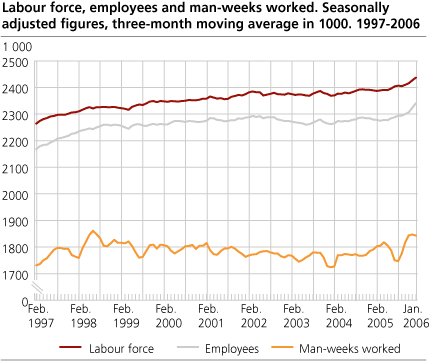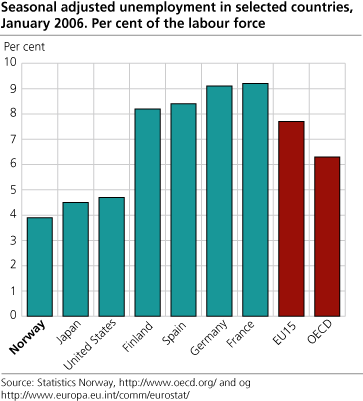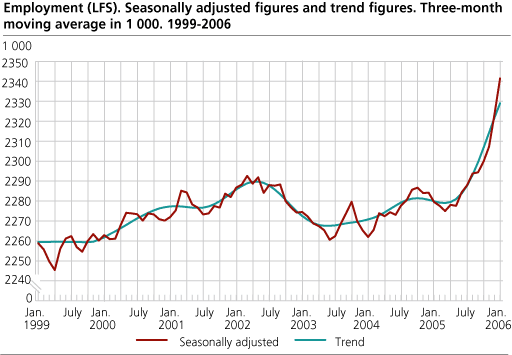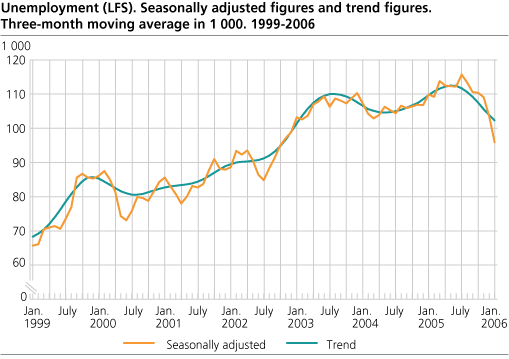Content
Published:
This is an archived release.
Significant improvement of the labour market
Unemployment fell and employment rose from October 2005 to January 2006. The figures presented in this article are adjusted for seasonal variations.
With effect from January 2006, some improvements have been made in the Norwegian Labour Force Survey (LFS). This will influence the figures on seasonally adjusted unemployment, employment and man-weeks worked. Between 2005 and 2006, there will be a statistical break in the time series. For more details on the LFS, the seasonal adjustment method and the changes in the LFS, you can click on the links at the left side of this page.
The number of employed people increased by 42 000 from October (the September-November period) 2005 to January (December-February) 2006, according to the LFS. The employment figure has been estimated to have increased by up to 9 000 as a direct effect of the changes in the LFS. An increase of 33 000 employees is consistent with the development since the summer of 2003, when the LFS uncertainty is taken under consideration.
Unemployment in January 2006 was 15 000 lower than in October 2005. The decline has been preliminary estimated to be around 2 000 too high as a consequence of the change in the LFS. A decline in unemployment of 13 000 people is consistent with the development in recent months, when the LFS uncertainty is taken under consideration. Seasonally adjusted figures of registered unemployment at job centres show a decline of 7 000 people from October 2005 to January 2006.
Fall in unemployment in the USA
The seasonally adjusted unemployment rate for Norway was 3.9 per cent in January 2006, compared with 4.6 per cent in October 2005. The rate in the EU15 area remained unchanged at 7.7 per cent, but fell in the OECD area from 6.5 to 6.3 per cent. In the same period, unemployment fell from 4.9 to 4.7 per cent in the USA. From October to January, the rate fell from 8.3 to 8.2 per cent in Finland, and from 9.3 to 9.2 per cent in France. In Germany, unemployment remained unchanged at 9.1 per cent, according to figures from the OECD and Eurostat .
Man-weeks worked
From October 2005 to January 2006, man-weeks worked rose by 26 000, which is outside the LFS error margin. The increase is consistent with the upward trend since the spring of 2004. Also the man-weeks worked figure for January (the December-February average) 2006 will be extra uncertain because of the changes in the LFS. However, we will be more able to measure absence from work after the LFS change. Calculations indicate a downward adjustment as a direct result of the changes made to the LFS questionnaire.
Uncertain figures
Quality tests show that the seasonally adjusted LFS unemployment figures are uncertain. The seasonal adjustment method has problems identifying a stable seasonal pattern for this series. The random component is relatively large compared with the seasonal component. The figures should therefore be treated with caution.
The purpose of making adjustments for seasonal variations is to describe the development over the last year and provide figures of change between the last two three-month periods, corrected for normal seasonal variations. In order to reduce uncertainty, the published series are three-month moving averages of the seasonally adjusted figures. For instance, the figures for January represent the average of the estimates for December, January and February.
Tables:
The statistics is published with Labour force survey.
Contact
-
Arbeidsmarked og lønn
E-mail: arbeidsmarked@ssb.no
-
Erik Herstad Horgen
E-mail: erik.horgen@ssb.no
tel.: (+47) 93 08 68 62





